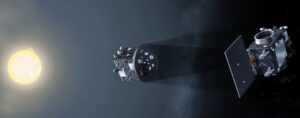On December 5, 2024, the European Space Agency (ESA) conducted the launch of the Proba-3 mission using a PSLV-XL rocket from India’s Satish Dhawan Space Center. The mission, which involved 40 organizations from 14 countries, including seven Polish companies and institutions, aims to make groundbreaking studies of the solar corona and demonstrate advanced technology for maintaining satellite formation in space.
Artificial Solar Eclipse
The Proba-3 mission is the first experiment in which two satellites – the Coronograph Spacecraft (CSC) and the Occulter Spacecraft (OSC) – will create an artificial eclipse of the Sun in orbit, allowing as much as six hours of observations of the solar corona. The Sun’s disk, which is much brighter than its corona, will be obscured by the oculographic disk, allowing the coronagraphic telescope on the CSC to study fainter phenomena such as coronal mass ejections and the solar wind. The mission will provide data that until now could only be acquired during natural eclipses lasting a few minutes, occurring once to twice a year.
The formation flying of the Proba-3 satellites requires precision to the nearest millimeter. The pair holds position at about 150 meters from each other in a highly elliptical Earth orbit with an apogee of 60,000 km and a perigee of 600 km. Technologies developed as part of this mission may find applications in future space operations, such as satellite refueling, orbital repairs, or even the search for exoplanets through advanced coronography.

Polish contribution
 Polish institutions, including the Space Research Center of the Polish Academy of Sciences, were crucial to the mission’s success. The Space Research Center of the Polish Academy of Sciences provided the coronograph, developed the scientific software and planned instrument operations. The participation of Polish scientists in this prestigious mission confirms their leading role in global space exploration.
Polish institutions, including the Space Research Center of the Polish Academy of Sciences, were crucial to the mission’s success. The Space Research Center of the Polish Academy of Sciences provided the coronograph, developed the scientific software and planned instrument operations. The participation of Polish scientists in this prestigious mission confirms their leading role in global space exploration.
Proba-3 is the fourth mission in the Proba series, initiated by ESA in 2001. It proves that small, experimental satellites can introduce breakthrough technologies. In the long term, their development opens up new possibilities not only in solar exploration, but also in the exploration of other planetary systems and Earth monitoring.
The Proba-3 mission, with a budget of about 200 million euros and a planned duration of two years, represents a significant step in the development of European and global space research.
Sources: ESA, Spaceflight Now / Photo and graphic: esa.int







